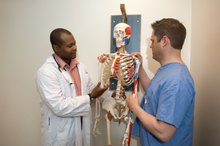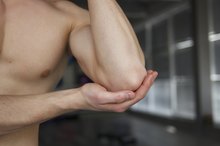How to Lose Weight With an Arthritic Hip
Hip arthritis is a degenerative condition in which your hip joint and the cartilage that works as a shock absorber start to wear down, causing pain, swelling and discomfort. If you are overweight and experience hip arthritis, the added weight can place greater strain on your hip and aggravate arthritis pain. Combining a healthy diet with exercises that do not overly strain your hip can help you lose weight and feel stronger. Check with your physician before beginning an exercise program to ensure your hip is in good enough condition to begin exercising.
Eat a diet that focuses on whole grains, vegetables, fruits and lean protein. These foods are filling yet low in calories and can help you achieve weight loss. Your goal should be to consume fewer calories than you burn throughout the day. Combined with an exercise program, this will result in weight loss.
How to Swim With Hip Pain
Learn More
Cut out “junk” foods that have little nutritional redeeming value, such as alcohol, desserts and fried foods. These items tend to be high in calories and can leave you feeling sluggish instead of energetic.
Engage in some form of low-impact aerobic activity -- the kind that gets your heart pumping -- at least three times per week. You can alternate exercise types to minimize strain on your hips, such as walking one day and taking a water aerobics class the next, according to the Texas Hip and Knee Center. If your choose walking, the center recommends starting with a distance as short as 100 yards at an intensity that does not cause pain and working your way up. This will help you burn calories and maintain flexibility in your hip.
How to Jog With Patellar Chondromalacia
Learn More
Take a water aerobics class to burn calories without placing too much strain on your joints, recommends the Texas Hip and Knee Center. You may find water aerobics in heated pools especially beneficial because the warmth can help to relieve your arthritis pain and encourage hip flexibility.
Ride a stationary bicycle at a resistance where you can pedal for 60 to 90 revolutions for 20 to 30 minutes without pain, recommends the Texas Hip and Knee Center. Setting the appropriate seat height is vital to reducing hip pain -- you should be able to just touch the pedal with your heel when your leg is fully extended.
Engage in hip-strengthening exercises as much as three times per day, recommends PhysioAdvisor, a physical therapy and training website. An example includes lying on your back and pulling one knee toward your chest as much as you possibly can pain-free for 10 to 20 repetitions. Put your knees on the floor and lift your hips in the air, holding for two seconds. Repeat 10 times.
Warnings
Avoid performing any exercises that aggravate your hip pain, especially strength-training exercises. Notify your physician if your pain becomes so severe you have difficulty completing even short exercise sessions.
Related Articles
References
Writer Bio
Rachel Nall began writing in 2003. She is a former managing editor for custom health publications, including physician journals. She has written for The Associated Press and "Jezebel," "Charleston," "Chatter" and "Reach" magazines. Nall is currently pursuing her Bachelor of Science in Nursing at the University of Tennessee.









